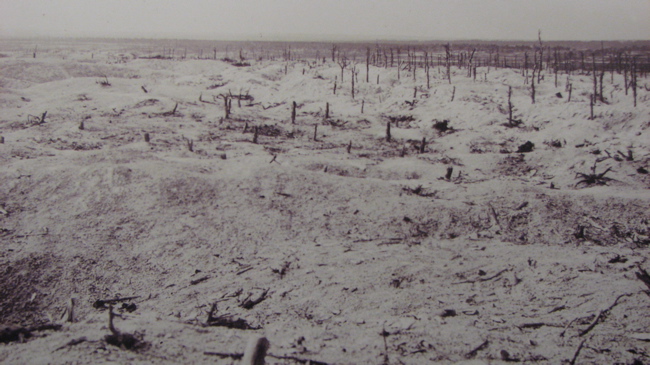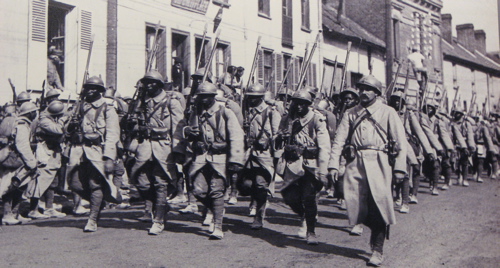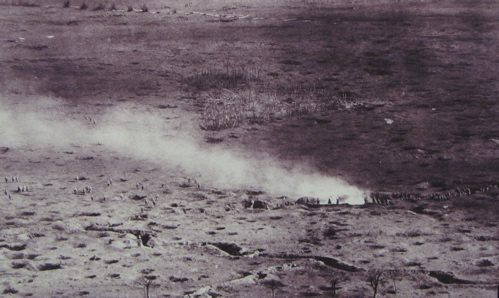War photography
The landscape on the western front
.
 The Somme Salient, October 10, 1916.
The Somme Salient, October 10, 1916.
World War One
During the Great War of 1914-1918, The French and the British had planned a counter-offensive to drive the German Imperial Army out of Belgium. The Battle of the Somme was one of the largest conflicts on the western front and it ended in stalemate after a disastrous allied advance. The loss of life following the --until that time-- largest artillery barrage was due to poor maps, outmoded tactics, and an insistence of command to continue the assaults in the face of withering German machine gun and artillery fire that was supposed to have been silenced.
The photograph above of the landscape obliterated by artillery bombardment give but a slight indication of the extent of this battle's gruesomeness. The staggering losses on both sides altered British, French and German recruitment and allocation schemes. Except for the German assault upon, and French defense of, Verdun, the Somme saw the loss of more lives than any other encounter during the First World War.
Etymological Dictionary.
The Great War
The United States came late to the fighting in Europe that by the time the Somme offensive started, Italy had joined the United Kingdom, France and Russia in an attempt to defeat Germany, Austria-Hungary and the Ottoman Empires. From August 1914 until November 11, 1918 millions of Europeans and their colonial possessions fought a bitter war for control of Eastern Europe and the Balkans.

French colonial troops from Senegal march through Paris, 1914, on their way to the front.
Background
The First World War is considered by many knowledgeable historians to be the the Great War (1914-1918), called "The War to end all wars." On the insistence of Austria, the Serbian nation refused to meet demands and called for support from her Russian allies in the summer of 1914 to fend off the Austro-Hungarian threats. The Austrian secret police had asserted and the Austro-Hungarian government agreed that the assassination of the heir to the Austrian throne in Bosnia had been masterminded by Serbian national extremists. In retaliation for the murder of the Austrian Archduke and his wife in Sarajevo that summer of 1914, Austria demanded Serbia surrender its sovereignty. Russia was allied with Serbia and threatened Austria. Austria with her ally Germany's backing threatened to mobilize her Army to march on Serbia. In response to Austria, Russia also planned to mobilize and asked support from her French ally. When the Germans in response to Russian and French mobilization countered by mobilizing their troops the stage was set for an immense conflict. Armies of a million or more troops were massed on the eastern and western sides of Germany.
With a huge Russian Army massing the Germans were faced with a two front war that required a strategy to quickly take out the French, as they had done in 1870. The problem in the German strategic plan for the western front is that it required for Germany to occupy Belgium and assault France from the north and the English Channel. Neutral Belgium resisted the German offensive calling on French aid and her alliance with Britain. Germany from its perspective felt there was no other option given the enormous size of the Russian army and the extent of the fighting German intelligence projected in the eastern front.
Because the Germans attacked France across the neutral Belgian frontier, the United Kingdom, though an ally of France and Russia entered the war badly divided but insisting that it was necessary to assure Belgian neutrality against German aggression. By September 1914 the largest war in history --until that time-- had started over an unresolved crisis in the Balkans.

Trenches and troops advancing; the Somme salient, October, 1916.

 The Somme Salient, October 10, 1916.
The Somme Salient, October 10, 1916. 